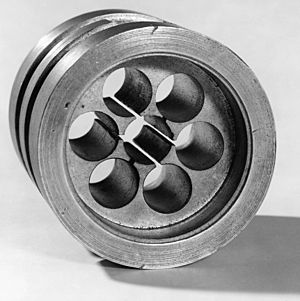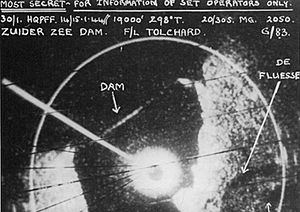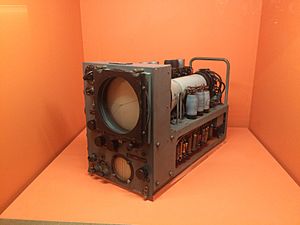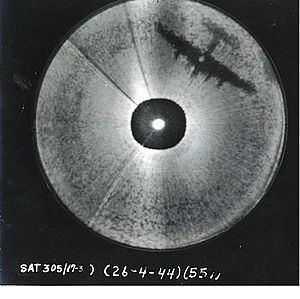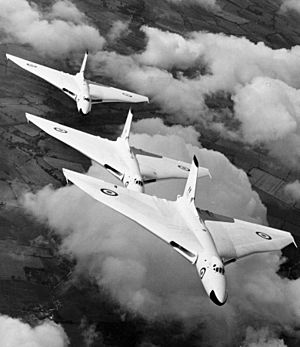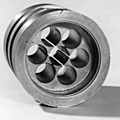H2S (radar) facts for kids
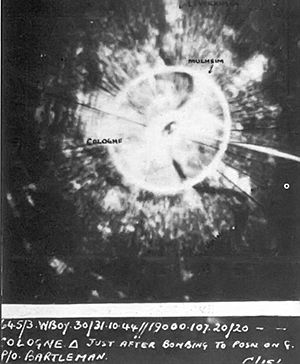
H2S was the very first radar system that could scan the ground from an aircraft. It was created for the Royal Air Force's Bomber Command during World War II. Its main job was to help bombers find targets on the ground at night or in bad weather.
This new radar allowed planes to attack targets far beyond the reach of other navigation systems like Gee or Oboe. These older systems only worked up to about 350 kilometers (217 miles) from ground stations. H2S also became a great tool for general navigation, helping pilots spot landmarks from far away.
In March 1941, scientists noticed that different things on the ground, like water, open land, and cities, looked different on radar. This was during tests of an early airborne interception radar. In January 1942, a new team started working to combine this idea with a special display that showed a map. The first test in April proved that a radar map of the area below the plane could be made. The first H2S systems, called H2S Mk. I and H2S Mk. II, started service in early 1943.
Sadly, on its second mission in February 1943, an H2S unit was captured by German forces. Another was captured a week later. The Germans learned it was a mapping system. When they put one together and saw a map of Berlin, it caused a lot of worry in the Luftwaffe (German air force). This led to the creation of the FuG 350 Naxos radar detector in late 1943. Naxos helped German night fighters find H2S signals. The British found out about Naxos, and there was a big debate about whether to keep using H2S. But later, they found that losses were actually lower after Naxos appeared, so H2S continued to be used.
Later in 1943, a new version, the H2S Mk. III, was developed. It used a shorter wavelength (3 cm or 1.2 inches) to get clearer images. Around the same time, America introduced its own version called H2X. Many different Mk. III versions were made. Development continued after the war with the Mk. IV and into the 1950s with the Mk. IX. This later version was used on the V bomber fleet. The H2S Mk. IX was last used in combat during the Falklands War in 1982 on the Avro Vulcan bomber. Some H2S Mk. IX units were still used on Handley Page Victor aircraft until 1993, giving it fifty years of service!
Contents
What Does "H2S" Mean?
The radar was first called "BN" (Blind Navigation). But it quickly became "H2S." The exact reason for this name is a bit of a mystery, with different stories.
Some say it meant "Height to Slope" or "Home Sweet Home." The "S" was already used by another radar team to mean "sentimetric" wavelength, which is how the S band got its name.
A popular story says it was named after hydrogen sulphide (chemical formula H2S), which smells like rotten eggs. The inventor supposedly thought it was "rotten" that he hadn't thought of pointing the radar down sooner to track the ground, instead of just using it to find other planes.
Another story, told by R. V. Jones, a science intelligence director, adds a twist. He said that a misunderstanding caused delays in the project. When Lord Cherwell, a science advisor to Winston Churchill, found out about the delay, he kept saying "it stinks!" The engineers then named the project "H2S." Later, when Cherwell asked what H2S stood for, no one dared tell him. So, they quickly made up "Home Sweet Home," which Cherwell then told everyone else.
How H2S Was Developed
The Idea Behind H2S
After the Battle of Britain, the RAF started bombing German cities at night. But a report showed that most bombs missed their targets by a lot. Some even landed 50 kilometers (31 miles) away!
New radio systems like Gee and Oboe helped, but they only worked for targets close to Britain. They couldn't reach deep into Germany.
Before the war, a scientist named Taffy Bowen noticed that radar signals bounced back differently from fields, cities, and the sea. Cities, with their tall buildings, gave much stronger signals. He thought this could be used for targeting, but the idea was forgotten.
In 1940, two students, John Randall and Harry Boot, invented the cavity magnetron. This small device could create powerful microwave radio signals at 9 cm (3.5 inches) wavelength. At this short wavelength, radar antennas could be much smaller, making them easier to fit into planes. The idea of radar mapping came back in March 1941 when a new radar, "AIS," showed clear images of objects on the ground.
Starting the Project
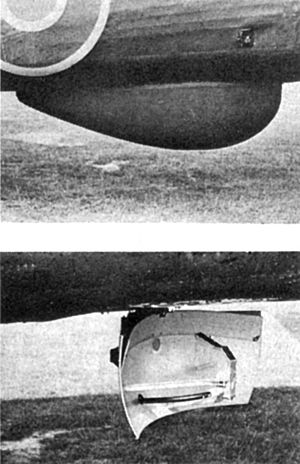
In October 1941, Philip Dee, one of the scientists, showed how AIS could map the ground. He used an AIS radar on a Blenheim plane and saw the outline of a town 35 miles (56 km) away from 8,000 feet (2,400 meters) up.
RAF commanders were very impressed. On January 1, 1942, a team led by Bernard Lovell was set up to build an airborne mapping radar based on AIS. They decided to use a Plan Position Indicator (PPI) display, which would show a map-like view.
The first test flight of H2S happened on April 23, 1942, on a Handley Page Halifax bomber. The radar scanner was placed in the plane's belly, covered by a special dome called a radome.
One challenge was that close objects looked much brighter on the display than far-away ones. This made the area right under the bomber too bright. The solution was to adjust the radar's power so that all objects appeared with similar brightness.
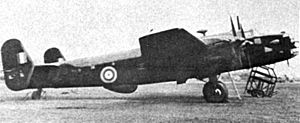
On June 7, 1942, the Halifax testing H2S crashed. Everyone on board died, including Alan Blumlein, the main designer. This was a huge setback for the project.
The Magnetron Debate
As H2S development continued, a big debate started. While H2S was great for bombing in any weather, losing an H2S plane could reveal the secret of the magnetron to the Germans. The magnetron was a very important and secret invention.
Lord Cherwell, Churchill's science advisor, wanted H2S to use a different, less secret device called a klystron. But the magnetron was made of a solid block of copper, making it very hard to destroy if a plane crashed. If the Germans got a magnetron, they would quickly understand how it worked. This could help them build their own advanced radars and detectors.
The H2S team argued that klystrons were not powerful enough. Tests showed magnetrons were much better. They also believed it would take the Germans two years to develop their own radar even if they captured a magnetron.
Despite the worries, Churchill personally approved the use of the magnetron for Bomber Command on September 15. It was decided that the risk was worth the benefit.
Moving the Radar Teams

The British radar groups had to move several times during the war to avoid German attacks. They started at Bawdsey Manor, then moved to Dundee, then to RAF St Athan, and finally to Swanage. Each move caused delays and problems.
In May 1942, a British commando raid captured a German Würzburg radar from the French coast. This made the British worry that the Germans might try a similar raid on their radar sites. Reports of German paratroopers near Cherbourg caused a panic. So, the radar team had to move again, this time to Malvern College, about 160 km (100 miles) north. This provided office space but caused more delays in the H2S project.
H2S in Action
First Missions
Despite all the challenges, Churchill demanded 200 H2S sets by October 1942. The team worked under huge pressure. They didn't meet the deadline, but by January 1943, 24 bombers had H2S.
On January 30, 1943, thirteen "Pathfinder" force planes used H2S to mark targets in Hamburg. Other bombers followed, using the flares as their target. The results were good. Similar raids happened in Turin and Cologne.
By February 21, it was decided that all Bomber Command planes would get H2S, not just for bombing but also for navigation. H2S was so good at finding coastlines from far away that it became a key navigation tool in all weather.
The Production Version: H2S Mk. II
The first H2S sets were prototypes, built quickly. The production version, the Mk. II, was largely the same but easier to build.
Bomber Command started using H2S widely in summer 1943. On July 24, the RAF launched Operation Gomorrah, a massive attack on Hamburg. With Pathfinders marking targets using H2S, RAF bombers caused a huge firestorm that burned large parts of the city. About 45,000 people died.
The Mk. II was soon updated to the Mk. IIA, which had small improvements to the antenna.
Making H2S Easier to Use
Early H2S flights showed some problems. For example, navigation charts always show north at the top, but the H2S display showed whatever direction the plane was flying. This made navigation confusing. Scientists quickly added a system connected to the plane's gyrocompass to keep the display always showing north at the top.
Another problem was that when the plane tilted, the radar signal would only hit the ground on one side, making half the display blank. This was fixed with a mechanical stabilizer that kept the scanner level with the ground.
Finally, objects far from the plane looked squashed on the display. A new system called the "scan corrected indicator" fixed this, making the map look more accurate at all distances.
Fishpond: Spotting Enemy Fighters
Radar works by sending out pulses and listening for echoes. The H2S display showed echoes from the ground. But there was a blank area in the center of the screen, representing the area directly under the plane. Operators noticed faint echoes in this blank circle and realized they were from other aircraft.
German night fighters often attacked from below, making them hard to see but perfectly placed for H2S to detect. However, the H2S display was small, and the blank area even smaller, making it hard to spot these enemy planes.
In early 1943, German night fighter attacks were getting better, and Bomber Command was losing many planes. Dudley Saward, a Bomber Command officer, asked the radar team if H2S could show enemy planes better.
The team realized they could build a special display that did the opposite of the main mapping display. Instead of removing the blank center, this new display would make the blank area fill the screen. This would make echoes from other aircraft much easier to see. They called this new display "Mousetrap," but then had to change it to "Fishpond" because "Mousetrap" was a secret mission name.
The first Fishpond units were used in October 1943. By spring 1944, most Bomber Command planes had it. The Fishpond display was usually at the radio operator's station. Many blips would appear from other friendly planes in the bomber stream. Enemy fighters were easy to spot because they moved around within the pattern of friendly blips. If a blip seemed to be approaching, the bomber would change direction to see if the blip followed. If it did, defensive actions would begin.
X-band: Clearer Images
The clarity of a radar image depends on the wavelength used and the size of the antenna. H2S used a 10 cm (3.9 inch) wavelength, which gave images that were not very clear. On February 6, 1943, work began on an X band version, using a shorter 3 cm (1.2 inch) wavelength. This would make images much clearer.
Bomber Command's large raids on Berlin in August and September 1943 showed that the older H2S was not very useful over such a huge city. It was hard to pick out features. So, on September 14, the team officially started working on the X-band H2S, now called H2S Mk. III.
The American MIT Radiation Laboratory was also developing its own 3 cm radar, called H2X, which was used on American bombers by October 1943.
The experimental H2S Mk. III was first used over Berlin in November 1943, and the results were "most outstanding." Mk. III was quickly put into production and became the main radar for Bomber Command until the end of the war. Many different versions of the Mk. III were made, each with small improvements.
The Rotterdam Device
The British had worried that H2S might fall into German hands. This happened almost immediately. On its second mission, during a raid on Cologne in February 1943, a Stirling bomber carrying H2S was shot down near Rotterdam. German technicians found the device almost intact.
They called it Rotterdam Gerät (Rotterdam apparatus). A second H2S unit was captured in March. The Germans learned from captured crew members that the device was used to find targets by scanning the ground.
When they put a captured H2S together and turned it on, clear images of Berlin appeared on the display. This caused great alarm for Hermann Göring, head of the Luftwaffe. As a quick countermeasure, they tried placing small corner reflectors around the city. These would create bright spots on the radar display in areas that should be empty, like lakes, to confuse the bombers.
The Germans quickly started working on ways to detect the H2S signals. They developed the Naxos radar detector, which allowed their night fighters to home in on the H2S transmissions.
The RAF didn't know about Naxos until spring 1944. This brought back the old debate about whether to keep using H2S. Losses among Bomber Command planes had increased. But a study showed that losses were actually lower after Fishpond was introduced. The study concluded that Naxos was mostly a propaganda tool to try and stop the British from using H2S.
In July 1944, a German Ju 88G-1 night fighter accidentally landed at a British airfield. The British captured its equipment, including the Lichtenstein SN-2 radar and the Flensburg radar detector. They learned that Flensburg detected the British Monica radar, not H2S. This was a huge relief. Monica was already being replaced by Fishpond, and planes with Monica were told to turn it off. H2S remained in use for the rest of the war.
As the British engineers had predicted, it took the Germans two years to develop their own magnetron-based radars. The first, the FuG 240 Berlin, was an AI radar similar to the British AI Mk. VIII. But Germany was close to defeat, and Berlin never saw widespread service.
After the War
After the war ended in Europe, older H2S models were retired. Work continued on the Mark IX, a new version designed for the first jet bombers, like the English Electric Canberra and later the much larger V-force (Valiant, Vulcan, Victor).
Unlike earlier H2S units that were added to existing planes, the Mk. IX was built right into the aircraft's design. It had a more powerful magnetron and a larger scanner, which made the radar images even clearer. The Mk. IX could also scan a smaller area more quickly, which was useful for faster jet planes.
The system also added "offset bombing." If the target wasn't visible on radar, the navigator could pick a nearby landmark that was visible. They would then tell the radar system the distance and angle between the landmark and the real target. The display would then shift, making it easier for the navigator to guide the plane so the landmark passed through the center of the screen, ensuring the bombs hit the actual target.
The Mk. IX was combined with other advanced navigation systems to create the Navigation and Bombing System (NBS). This system could automatically calculate wind speed and direction, making navigation very accurate. This meant fewer crew members were needed on some planes.
The first use of NBS in combat was in 1956. The system stayed in service with the V bomber force throughout their lives. Its last combat use was during the Falklands War in 1982, when Avro Vulcan bombers used it for navigation and bombing during their long flights. Some H2S Mk. IX units remained in service until 1993.
Different H2S Versions
- Mark I – The first prototype versions.
- Mark II – The main production version.
- Mark IIA – Improved antenna.
- Mark IIB – IIA with Fishpond displays.
- Mark IIC – IIB with improved display, stabilized scanner, and better antenna.
- Mark III – Prototype 3 cm (X-band) versions for clearer images.
- Mark IIIA – III with improved display and stabilized scanner.
- Mark IIIB – III with improved display (temporary version).
- Mark IIIC – IIIA with a larger, 6-foot (1.8 meter) scanner.
- Mark IIID – IIIA with a more powerful magnetron.
- Mark IIIE – IIIA with a new display and shorter radar pulses.
- Mark IIIF – IIIE with the larger scanner.
- Mark IIIG – IIC systems converted to 3 cm, mainly for long-range navigation.
- Mark IIIH – IIIG with a new display.
- Mark IV – Added altitude correction and links to navigation computers.
- Mark IVA – IV with the larger scanner, used on Avro Lincoln bombers.
- Mark VI – Operated at an even shorter 1.25 cm wavelength, also known as Lion Tamer.
- Mark VIII – An X-band version, replacement for Mk. VII.
- Mark IX, IXA – Mk. VIII with a very powerful magnetron and many other improvements. Used on the V bombers.
Images for kids


